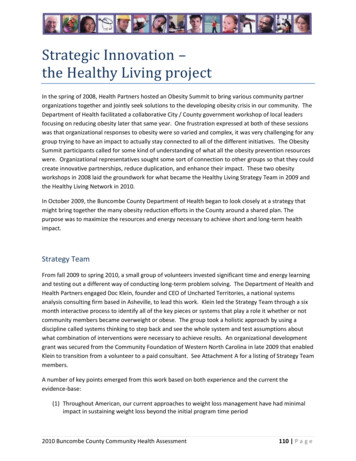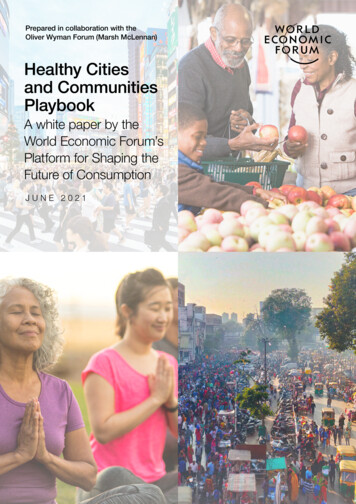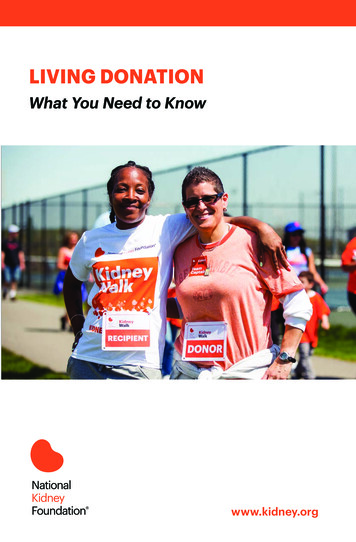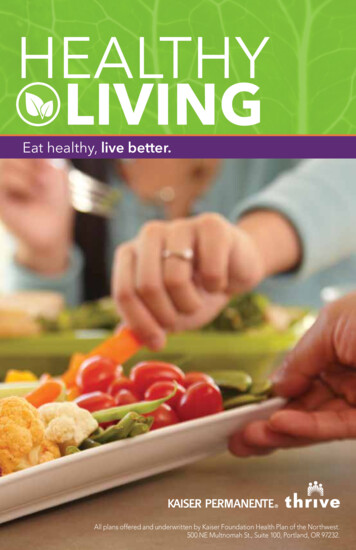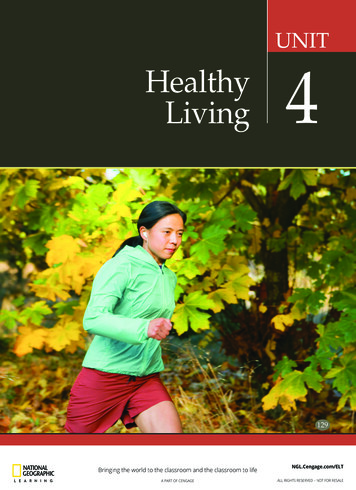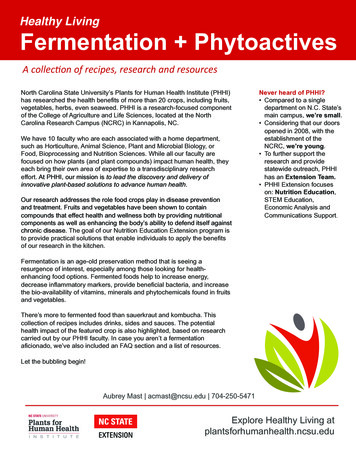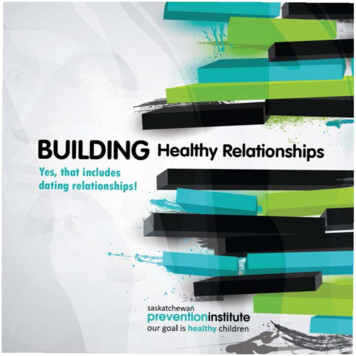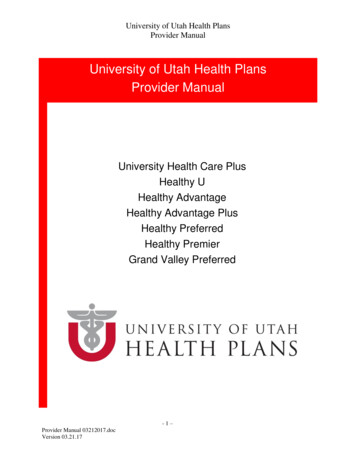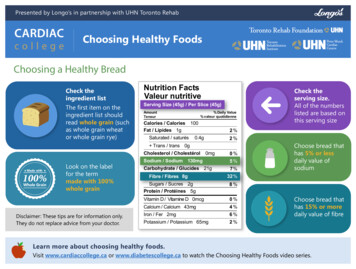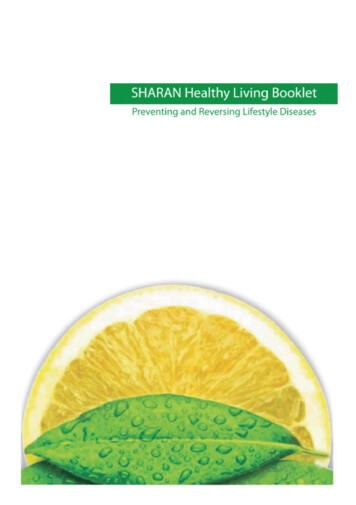
Transcription
ContentsCause of Diseases1Excess fatExcess proteinLack of fibreAcidic foodA Diet for Optimal Health24445Plant-based foodWhole foodNine principles of transitioning to a healthy diet15 guidelines for healthy eatingFrequently asked questionsDon’t I need animal products for protein?What about calcium? Don’t I need milk for calcium?What about vitamin D?What about iron and anemia?What about omega 3?What about vitamin B12?Do I need to take supplements?What about soy?What about children?What about athletes?Where can I get organic and whole, plant-based food?What else is important besides nutrition for health?Where can I learn more?Where can I get more support?5689101011121213131314141515151616
ContentsCause of Diseases1Excess fatExcess proteinLack of fibreAcidic foodA Diet for Optimal Health24445Plant-based foodWhole foodNine principles of transitioning to a healthy diet15 guidelines for healthy eatingFrequently asked questionsDon’t I need animal products for protein?What about calcium? Don’t I need milk for calcium?What about vitamin D?What about iron and anemia?What about omega 3?What about vitamin B12?Do I need to take supplements?What about soy?What about children?What about athletes?Where can I get organic and whole, plant-based food?What else is important besides nutrition for health?Where can I learn more?Where can I get more support?5689101011121213131314141515151616
Implementation18Step 1: Get testedStep 2: PrepareStep 3: ImplementStep 4: Monitor your resultsStep 5: Get tested againStep 6: Take the next stepsMake Your Food Delicious18192121222324Kitchen replacement chartMeal ideasBreakfast ideasLunch and dinner ideasSnack ideasSample recipesDairy alternativesBreakfast itemsSaladsSoupsMain coursesDessertsTop Five s67About Dr. Nandita Shah68
Cause of DiseasesOur bodies are always working to heal and to remain healthy.Most of the diseases that we face today—like diabetes,hypertension, heart disease, and obesity—are lifestyle diseases.In most cases, if you want to heal, you need to understandwhat part of your lifestyle is causing the disease, and thenchange it. Once the cause is removed, the body is free to heal.As long as the cause remains, disease reversal is difficult.The cause of disease is never the absence of medications.Medications usually control disease, but act against the body’shealing process. Taking medications without changing yourlifestyle is like continually mopping the floor instead of fixingthe leaky tap. The main causes of diseases today are: Physical (from faulty nutrition, chemicals, drugs, wrongmedications, and not enough water and exercise) Emotional (from stress and other emotional issues) Spiritual (from not following your spiritual purpose)All of these are interconnected.The Sanctuary for Health and Reconnection to Nature andAnimals (SHARAN) mainly helps people reverse diseasesthrough nutritional guidance, but also helps people connect toall three of the physical, emotional, and spiritual causes ofdisease. This means understanding what the natural diet forthe human species is.Just as a lion instinctually eats meat or a cow instinctually eatsgrass, human beings also have an instinctual diet. Because ofconditioning from society, we have forgotten these instincts;but it’s possible to reconnect with them because they are1
engraved in our DNA. SHARAN is a catalyst in the process ofhelping you reconnect to your instincts so that eating thecorrect food becomes second nature rather than a chore.There are four main nutritional causes of disease: Excess fat Excess protein Lack of fibre Acidic foodExcess fatFat thickens the blood, slowing down circulation and reducingoxygenation to every part of the body. This is the main cause ofmany diseases. The main cause of diabetes, hypertension, heartdisease, and obesity is excess dietary fat.Food that is high in fat includes: Animal products (meat, seafood, eggs, and dairy) andanything that is made from animal products Refined plant fats (e.g., oil, margarine, and vanaspati)and anything that is made from refined plant fatsNot only do animal products contain fat, they are also high incholesterol. Plants do not produce cholesterol—only animalsproduce cholesterol.2
The following table lists the cholesterol and fat content of 100gram servings of animal products versus plant-based food(Source: USDA Agricultural Research Service Nutrient DataLaboratory).Animalproduct(100gramserving)Fat (% ofcalories)Cholesterol (mg)Plantbasedfood(100gramserving)Fat (% ofcalories)Cholesterol ge40Milk4930Rice70People who eat a 100 percent plant-based diet (i.e., vegans)have the lowest average cholesterol levels: Non-vegetarians: 210 Lacto-ovo vegetarians: 161 Vegans: 1333
Excess proteinProtein is the nutrient for growth and repair. Excess protein isacid-yielding in the body. Diseases primarily caused by excessprotein include acidity, kidney failure, gout, osteoporosis, andcancer.Lack of fibreLack of fibre causes constipation, high blood sugar, andinflammation, which are the underlying causes of many healthproblems.Acidic foodThe body is naturally alkaline. Acid food leaches calcium andmagnesium from your bones and breaks down muscles. Allanimal products are highly acidic, while only high-protein typesof plant-based food (like beans and grains) are acidic.All fruit and vegetables are more alkaline. Therefore, youshould eat more fruit and vegetables.List of acidic substancesAnimal productsProcessed productsDairy (milk, cheese, etc.)Tea and coffeeEggsSaltMeat (chicken, mutton, etc.)Soda (Coca Cola, etc.)Seafood (fish, shellfish, etc.)VinegarAlcohol4
A Diet for Optimal HealthFor optimum health, your diet should be: Cholesterol-free High in fibre High in nutrients AlkalineA whole food, plant-based (vegan) diet meets all of thesecriteria and can help you get back to health.Research shows that vegans have lower rates of heart disease,high blood pressure, diabetes, obesity, rheumatoid arthritis,several types of cancer, asthma, acidity, gastric disorders, jointpain, backache, acne, and psychological problems.Before you eat something, check:1. Is it plant-based? (MOST important!)2. Is it whole? (as far as possible)Plant-based foodA vegan diet is a plant-based diet. A plant-based diet includesfruit, vegetables, legumes, grains, nuts, and seeds. A plantbased diet does NOT include any animal products like meat,seafood, dairy, and eggs.5
Whole foodFood, when refined, loses a lot of nutrients. We are the onlyspecies who systematically makes our food less nutritious!The following table lists the percentage of nutrients lost whenwhole-wheat flour is refined into white flour (source: FoodRevolution by John Robbins).NutrientPercentage ganese82%Niacin (vitamin B3)80%Pantothenic acid (vitamin B5) 56%Phosphorus69%Potassium74%Protein25%Riboflavin (vitamin B2)81%Selenium52%Thiamin (vitamin B1)73%Vitamin B687%Vitamin E95%Zinc76%6
SHARAN recommends a whole food, plant-based diet (i.e., awhole food, vegan diet).Eat whole food as far as possible. Whole food has not beenrefined or processed. Eating a whole food diet means that youshould: Eat unpolished rice instead of white rice, atta instead ofmaida, etc. Eliminate sugar and oil. Avoid juice and favour whole fruit and vegetables orsmoothies. Eat fruit and vegetables like a monkey would. In otherwords, only peel vegetables and fruit that you can peelwith your bare hands (this may not always be possible,but you should aim for this).7
Nine principles of transitioning to a healthy diet1. From refined grain to WHOLE grain2. From refined sweeteners (e.g., sugar) to UNREFINEDsweeteners (e.g., jaggery, palm sugar, and fruit juice)and WHOLE sweeteners (e.g., dates, raisins, and otherdried fruit)3. From juices to WHOLE fruit and vegetables andsmoothies (on an empty stomach)4. From extracted fats (e.g., oils and butter) to WHOLE fatslike nuts and seeds5. From peeled fruit and vegetables to UNPEELED andWHOLE fruit and vegetables6. From frying and over-cooking to POACHING,BLANCHING, STEAMING, and DRY ROASTING7. From all cooked food to 50 percent FRESH and RAWfood8. From pesticide- and chemical-laden food to ORGANICfood9. From animal-based products to PLANT-BASED food“When diet is wrong, medicine is of no use. When diet iscorrect, medicine is of no need.” Ancient Ayurvedic proverb8
15 guidelines for healthy eating1. Practice kindness and compassion towards yourself andyour food.2. Eat food that is anatomically suitable (plant-based).3. Eat whole rather than refined or processed food (nowhite rice, white flour, white sugar, or oil).4. Eat fresh, unprocessed food and avoid junk food andartificial, processed food.5. Wash food before chopping and cook in just the rightamount of water so that no nutrients are lost.6. Eat local, seasonal food.7. Choose organic over artificially-grown food.8. Always separate fruit from your main meal. You shouldeat fruit on an empty stomach, not after a meal.9. Avoid using the microwave and aluminium and nonstickutensils.10. Always read the list of ingredients to identify if it is realfood or a “food-like substance.”11. Eat mindfully, engaging all your five senses.12. Eat according to your hunger.13. Eat at least two hours before you go to bed.14. Bless the food and thank the people who made itpossible for you to enjoy the food in front of you.15. If it came from a plant, eat it; if it was made in a plant,don’t!9
Frequently asked questionsGet the answers to frequently asked questions about optimalhealth.Don’t I need animal products for protein?Human children and adults do not require animal products orcow’s milk for protein. You will get sufficient protein on a wholefood, plant-based diet.Protein is the nutrient for growth and repair. Every mammalproduces milk according to the growth needs of its young. Thefaster the growth rate, the higher the protein content in themilk.AnimalPercentage of protein in 10Guinea pig 8.55Rat8.70Dog10.11Cat11.10 Herbivores like horses, cows, and deer all get theirprotein from plants. Protein deficiency (kwashiorkor) occurs only in peoplewho get insufficient calories.10
It’s not necessary to eat “complete proteins” or go outof your way to get enough protein. Vegans do not need soy products, but may take some.What about calcium? Don’t I need milk for calcium?The best sources of calcium are found in plant-based food. Milk is not the best source of calcium. Only 30 percentof the calcium in cow’s milk is absorbed. Countries with the highest dairy intake are also thecountries with the highest incidence of osteoporosis. Green leafy vegetables (except spinach), nuts, and seedsare the best and sufficient sources of calcium.Calcium content of food (per 100-gram portion)Human breast milk33 mg Mustard greens (cooked) 138 mgAlmonds234 mg Mustard greens (raw)183 mgAmaranth267 mg Parsley203 mgApricots (dried)Beans (pinto, black)67 mg Pistachios131 mg135 mg Potato chips40 mgBeet greens (cooked)99 mg RaisinsBran70 mg Sesame seeds1,160 mgChickpeas150 mg Sugar (brown)85 mgFigs (dried)126 mg TofuKale (cooked leaves)Kale (raw leaves)Lettuce (dark green)87 mg Spinach (raw)249 mg Sunflower seeds68 mg Cow’s milk62 mg128 mg93 mg120 mg120 mg11
What about vitamin D?Vitamin D is needed to absorb calcium. Vitamin D is provided by direct sunlight on the skin.Anything in between the sun and the skin—includingclothes, windows, sunscreen, and even city pollution—will hamper the absorption of vitamin D. A half hour in direct sunlight every day is the best wayto get vitamin D. Vitamin D can be stored in the body. In urban areas all over the world, vitamin D deficiency isextremely common. Learn more about vitamin D.What about iron and anemia?A vegan diet will not make you anaemic. Non-vegetarians, vegetarians, and vegans can all sufferfrom iron deficiency. Iron is a mineral that is found in soil. Plants are a goodsource of iron—that’s where cows, goats, and otheranimals get their iron. Milk, tea, coffee, and calcium supplements impede theabsorption of iron. Anaemia can also be a result of excess bleeding,bleeding disorders, and parasites. In addition to iron, you need folic acid, which comeslargely from green leafy vegetables.12
What about omega 3?Your omega 3 and omega 6 levels should be in balance. Refinedoils contain a lot of omega 6; therefore, people who consumethem may need to take omega 3 supplements.Only plants make omega 3. Fish may have omega 3 because fisheat plants. You do not need fish to get your omega 3; you canget it from plants. Rich sources of omega 3 include pumpkinseeds, walnuts, soy, sesame seeds, flax seeds, and green leafyvegetables.What about vitamin B12?Vitamin B12 is the only vitamin that is deficient in a whole food,plant-based diet today because only bacteria produce vitaminB12. Because of our super-hygienic lifestyles, we don’t getenough vitamin B12. In addition, vitamin B12 absorption isfurther diminished by alcohol intake, microwaves, mobilephones, and mobile phone towers.It’s important that you get vitamin B12 from supplements(injections or tablets). Learn more about vitamin B12.Do I need to take supplements?Have your vitamin B12 and vitamin D levels checked. They arelikely to be low if you are not already taking supplements. Iflow, you should supplement these vitamins. View moreinformation on how to check and supplement these vitamins: Vitamin B12 Vitamin D13
What about soy?Eating soy in moderation is not harmful. Soy beans are rich in protein. Unlike animal protein, soyalso contains fibre and no cholesterol. It is also anexcellent source of antioxidants, phytochemicals, andnutrients that keep your cholesterol level down. Avoid genetically-modified (GM) soy (and other GMfood). At present, GM soy is not grown in India or mostof Europe, but it is widespread in the United States andcan be found in imported soy products. 90 percent of the soy grown in the world is fed toanimals raised for food. Anyone who consumes animalproducts is very likely to be consuming a lot of soyindirectly. Soy is just a bean. A little soy will do no harm. Like soy, broccoli, nuts, seeds, whole grains, berries,fruit, vegetables, and sprouts also containphytoestrogens. These are not harmful. Learn more about soy.What about children?Children thrive on a vegan diet. A carefully-planned, whole food, vegan diet can meet allof a child’s nutritional requirements after weaning. By setting an example yourself and teaching yourchildren to make healthy food choices, you will also begiving them a lifetime of good eating habits—and goodhealth!14
Because of the higher vitamin and mineral content ofplant-based food, vegan children are likely to havehigher intelligence quotients.What about athletes?A vegan diet is ideal for athletes. Excess protein causes the breakdown of muscles andbones. Many Olympic-level athletes are vegan. For example,Olympic track and field champion Carl Lewis achievedhis best results after he switched to a vegan diet!Where can I get organic and whole, plant-based food?Find a list of city directories, online organic stores, and veganproducts in India, as well as tips on eating out and other usefulinformation about how to get started on a vegan diet on thecity directories page of the SHARAN website.What else is important besides nutrition for health? Plenty of fresh outdoor air Exposure to sunlight Adequate water Regular exercise Adequate rest at the correct time Relaxation Healthy relationships and attitudes Respect for yourself and others Gratitude and benevolence Avoidance of harmful and addictive substances15
Where can I learn more?We recommend the following books: The China Study by T. Colin Campbell, PhD (about theeffects of animal proteins on our bodies) The McDougall Plan by John McDougall, M.D. (abouthow to stay healthy) Eat to Live by Joel Fuhrman, M.D. (about how to stayhealthy) The RAVE Diet & Lifestyle by Mike Anderson (abouthealth, eating, and beyond) Prevent and Reverse Heart Disease by CaldwellEsselstyn, M.D. Dr. Neal Barnard’s Program for Reversing Diabetes byNeal Barnard, M.D. There is a Cure for Diabetes by Gabriel Cousens, M.DView more recommended books and resources.Where can I get more support?SHARAN has various ways to support you in your quest forhealth. We conduct a variety of talks, seminars, workshops, andcooking classes in different cities. It’s important to staycurrent with the latest knowledge. You can alsoorganize these for your community, group, orcorporation. Email SHARAN to get information or checkthe SHARAN website for schedules.16
We conduct potlucks, lunch meetings, and informalevents to help you connect, share results or difficulties,and get your questions answered. We conduct holidays and retreats to help you reversediseases and relax. We create the right environment forhealth, learning, healing, and reconnecting to yourselfand nature. We offer phone and face-to-face consultations to helpyou reach your goal. If you cannot come to ourseminars, it’s still possible to reverse diseases. If youhave attended a seminar, we can help you movefurther, reduce medications, and guide you with anindividualized diet plan. Email SHARAN forconsultations. We offer news, announcements, and recipes throughour social media pages (make sure you follow us!):FacebookPinterestTwitterYouTube17
ImplementationTo reverse any disease, follow these six steps.Step 1: Get testedGet yourself checked so that you know the whole picture. Havethe following measurements and tests done: Height Weight Blood pressure Complete blood count (CBC) with erythrocytesedimentation rate (ESR) Liver function tests Kidney function tests Lipid profile Thyroid function tests Vitamin B12, homocysteine, and vitamin D Fasting blood sugar (FBS) Postprandial blood sugar (PPBS) and glycatedhemoglobin (HbA1c) (if you have diabetes) Routine stool (if relevant) Routine urine (if relevant) Electrocardiography (ECG) (if relevant)18
Step 2: Prepare1. Prepare a chart to track your progress. This chart will bea record from which you can learn and change asneeded, and will be helpful to you and your doctor. Youcan use the sample progress chart on page 20 of thisbooklet or create your own. Your chart should includeyour: Blood pressure level (weekly, daily, or several timesa day, depending on your condition) Blood sugar level (weekly, daily, or several times aday, depending on your condition) Weight (weekly) Medications and supplements (daily) Food intake (daily so that, in the long run, you canmonitor whether anything you eat does not agreewith you) Exercise (daily)19
20DateBPFBSSample progress chartPPBSWeightFoodMedsExerciseNotes
2. Shop for whole, plant-based food. You can use thekitchen replacement chart on page 24 of this booklet.3. If needed, learn some new whole, plant-based foodrecipes. See the sample recipes section on page 31 ofthis booklet.4. Plan your menu for the next seven days. Make sure youhave all the ingredients you’ll need, except maybe freshfruit and vegetables that you can buy as needed.5. Read the information in the Try Vegan section of theSHARAN website.Step 3: Implement1. Start eating a 100 percent whole food, plant-based diet(or as much as you possibly can).2. If your vitamin B12 level is low, start taking injections ororal supplements. Learn more about vitamin B12.3. If your vitamin D level is low, spend additional time indirect sunlight or, if you live in a polluted city, takesupplements. Learn more about vitamin D.Step 4: Monitor your results1. Every day, fill in your progress chart with your diet,exercise, medications and herbal remedies, bloodpressure level, blood sugar level, and any unusualsymptoms. See the sample progress chart on page 20 ofthis booklet.2. Add your weight to your progress chart every week.3. Note in RED all your episodes of low blood sugar (lessthan 80 mg/dL or 4.5 mmol/l) and low blood pressure21
(less than 120/80). Start monitoring your blood sugarlevel from day one as the change in diet worksimmediately in some people and low blood sugarepisodes (hypoglycemia) can happen right away.Symptoms of hypoglycemia include nervousness,sweating, intense hunger, trembling, weakness,palpitations, and trouble speaking. Keep somethingsweet like dates or raisins readily available in case youhave a hypoglycemic episode (it can happen in the nighttoo). Symptoms of low blood pressure includeweakness, faintness, and lightness.4. Reduce your medications as soon as you improve. Youmay need guidance to reduce your medications. Askyour doctor or a SHARAN doctor for advice. If you’rediabetic, reduce your medications when your fastingblood sugar level falls below 100 or you have ahypoglycemic episode. If you have no access toguidance, cut medications very slowly, checkingconstantly. If you are on insulin, cut down your insulinunits one or two at a time. If you are on medications,you can halve the dose of one of them. It’s safest to cutthe medication that you started last if you have no help.If you are taking blood pressure medications, keepchecking your blood pressure and cut medications tokeep it in an acceptable range.Step 5: Get tested againAfter three months, repeat relevant lab tests in accordancewith advice from your doctor or a SHARAN doctor.22
Step 6: Take the next stepsBy adopting a whole food, plant-based diet, you may have seen100 percent results or a partial result. A partial result meansyou have reduced your medication dosage, but are still takingone or more medications. You may need further guidance froma SHARAN doctor, who will fine-tune your diet and lifestylebased on your health status. It is important to understand thatto maintain positive results, you need to maintain the new diet.If available in your city, join SHARAN support group meetings toget inspired and hear and share experiences with others. Youcan also like the SHARAN India Facebook page and join theStaying Vegan with SHARAN Facebook group and other groupsto ask questions, get help reversing your disease, and beinspired by the results of others. Come back for our potlucks,lunch meetings, or even repeat or join more SHARAN seminars.You’ll learn something new each time, which will help you go tothe next level.Remember: Your health is now in your hands! Anyone can gethealthy again with a few simple steps.23
Make Your Food DeliciousLearn how to cook delicious, whole, plant-based food.Kitchen replacement chartThe following table lists common animal-based, refined, andprocessed food/ingredients and suggested replacements.Food/ingredientReplacement optionsButterAlmond butter, avocado, cashew butter,peanut butter, and sesame butter (as aspread)ButtermilkButtermilk made from plant-basedcurd/yoghurt (view our soy buttermilk recipe)Canned and frozenfoodFresh alternatives whenever possibleCheeseCheese made from plant-based sources suchas nuts, seeds, and legumes and nutritionalyeast flakes (view our non-dairy cheeserecipes)Chocolate (milk)Cocoa powder or dark chocolateCreamCashew or other nut butters mixed withwater and ground (view our plant-basedcream recipes)Curd/yoghurtCurd/yoghurt made from plant-based milksuch as soy and peanutEggsMany different options, depending on the use(view our egg replacers)Fried foodOil-free baked or roasted alternatives24
Food/ingredientReplacement optionsGheeNuts, seeds, and legumes such as cashews,coconut, peanuts, and sesame seedsIce creamIce cream made with plant-based milk or fruitand no sugarKhakraOil-free ambil khakraMayonnaiseCashew mayonnaise (oil-free) (view ourrecipe on page 48)Meat and seafoodSoy nuggets and flakes, tofu, beans, readymade meat replacers (e.g., Fry’s burgers), andraw jackfruitMilkMilk made from plant-based sources such asalmonds, coconut, corn, oats, peanuts, rice,sesame seeds, and soyOilNuts, seeds, and legumes such as cashews,coconut, peanuts, and sesame seedsPaneerTofu or “soy paneer” and tofu marinated incashew creamReady-madecerealsMuesli made with whole flakes, nuts, anddried fruit and roasted, whole-grain daliassuch as wheat, barley, maize, millet,amaranth, and rolled oats (not quick-cooking)Salad dressingOil-free salad dressing and chutneySalt (iodized)Himalayan, rock, or sea saltSoft drinksWater, lime juice with water, fruit smoothie,etc.Sugar, honey, andartificialsweetenersDried fruit such as dates and raisins (ideally)and jaggery, raw/unrefined sugar, or palmsugar (rarely)25
Food/ingredientReplacement optionsTea and coffeeHomemade herbal infusions from herbs andspices, ready-made herbal teas, and barley orsoy coffeeWhite flour (maida)and breadFlour and bread (e.g., chapatis and rotis)made from whole wheat (atta) or otherwhole grains like millet (e.g., jowar, bajra, andnachni/ragi), brown rice, and spelt (mostwheat breads in the market containemulsifiers and fat)White riceWhole, unpolished rice such as brown or redriceMeal ideasGet whole, plant-based food ideas for every meal.Breakfast ideasBreakfast ideas include: Fresh fruit Green smoothie Oil-free whole dalia or millet upma with addedvegetables Bhaidku (Indian-style porridge) Oat porridge (use old-fashioned, whole oats or steel-cutoats, not the quick-cooking ones) Muesli Idli, dosa, or uttapam made with whole rice or milletand whole urad daal and served with coconut chutney26
Oil-free brown or red rice poha with vegetables Tofu akuri or scrambled tofu Whole-wheat khakhra or stuffed paratha withvegetables, chutney, and vegan curd Whole-grain bread or chapati with vegan spreads likehummus Sprout, moong, or other daals or besan chillas withvegetables and chutney Homemade baked beans on whole-grain bread orchapati Chapati or whole-grain bread with nut butter, avocado,or coconut coriander chutney Vegetable cutlets breaded with crushed peanutsReplace tea or coffee initially with green tea and later withherbal infusions/teas made out of mint (pudina), fennel (varialior saunf), cardamom (elaichi), ginger, black peppercorns,lemongrass, tulsi, lemon, etc. The teas made with fresh herbsdo not need to be boiled as they are infusions. Put the herbs ina mug, pour hot water over them, and let them steep for a fewminutes, according to your taste.Add your ideas:27
Lunch and dinner ideasIndian and non-Indian lunch and dinner ideas include:Indian meals Salad, katchumber, and kosambari Sprouts, sprout chaat, and sprout salad Oil-free Indian vegetable dishes (replace oil with seedsor nuts and cream with cashew paste) Daal, sprouts, and beans Plant-based curd and buttermilk Whole-wheat or millet rotis and whole rice or millet Stuffed, whole-wheat parathas Khichadi and kadhi Idli, dosa, masala dosa, or uttapam made with wholerice and served with oil-free sambhar and chutney Oil-free pudlas, chillas, or theplas with mixedvegetables like dhoodhi, cabbage, and methi servedwith plant-based yoghurt or chutney and subziNon-Indian meals Soup and whole-grain or lentil bread with veganspreads like hummus Soup and a toasted whole-wheat or lentil breadsandwich with chutney or vegan cheese andvegetables Baked vegetables and whole-grain toast Mexican bean burritos, enchiladas made with nocheese or vegan cheese, or baked tacos filled withvegan toppings28
Italian pasta with marinara sauce, pasta withvegetables, or minestrone soup Chinese soup, steamed whole rice or whole-grainnoodles with vegetables in Chinese sauce, and kimchi Lebanese salads, baked falafel, oil-free hummus, babaganoush, whole-wheat pita, and tahini Japanese salads, whole rice vegetable sushi, and misosoupAdd your ideas:29
Snack ideasSnack ideas include: Fresh fruit Green or fruit smoothies Nut and seed milk smoothies Chaats, sprout chaat, chhole chaat, and aalu chaat Unsalted nuts and roasted chickpeas (chana) Any of the breakfast ideas mentioned on page 26 Cucumber and tomato salad with peanuts, freshlygrated coconut, coriander, and lemon Steamed dhokla made with brown rice and urad daal,moong daal, mixed daal, or chola Oil-free khakhara Sprout bhel or bhel with baked sev and puri Oil-free roasted snacks or popcorn Vegetable sticks with nut butter, hummus, or other dipsand spreads made from beans, tofu, and vegetables Homemade granola bars or date and nut bars Whole-wheat or lentil bread sandwichesAdd your ideas:30
Sample recipesThese are just a sample of the large number of healthy veganrecipes that you can use. View more recipes.Dairy alternatives31Breakfast items36Salads40Soups49Main courses51Desserts59Dairy alternativesLearn how to make delicious, plant-based alternatives to dairyproducts like milk, yoghurt/curd, cheese, and butter.Soy milkMakes about 6 glassesIngredients 1 cup soy beans soaked in water overnight 1 date (optional) WaterMethodDrain and discard the soaking water from the soy beans.Grind the soy beans and optional date in the blender ormixer, making a smooth paste. Add water until you haveyour desired consistency. Boil the milk in a saucepan for31
20 minutes, stirring while it boils. Strain. (You can use thepulp/okara in other recipes like muesli cookies or cutlets.)Cool and serve or refrigerate. You can use therefrigerated milk for up to three days.Coconut milk and other nut and seed milkAlthough all types of plant-based milk is made in a similarmanner, coconut milk is not a whole food because itneeds to be sieved. However, you can make other typesof nut milk without sieving, which makes them a bitbetter than coconut milk. Choose the best type of plantbased milk for taste and suitability in the recipe.Makes ½–¾ of a litreIngredients 1 cup mature, freshly-grated coconut 2 cups warm waterMethodGrind the coconut and one cup of the warm water in agrinder or food processor. Strain the mixture
hypertension, heart disease, and obesity—are lifestyle diseases. In most cases, if you want to heal, you need to understand what part of your lifestyle is causing the disease, and then change it. Once the cause is removed, the body is free to heal. As long as the cause remains, disease reversal is difficult.
